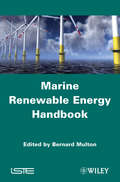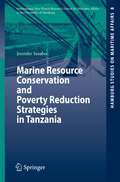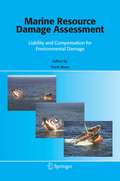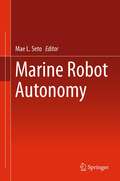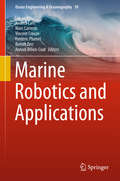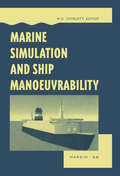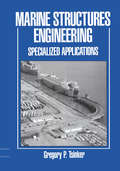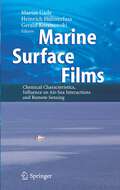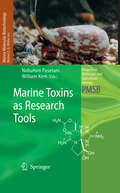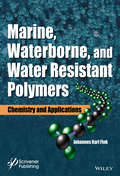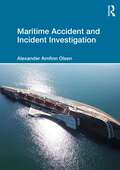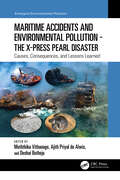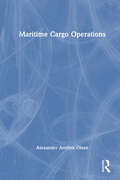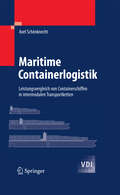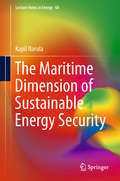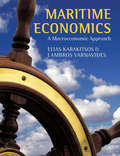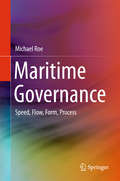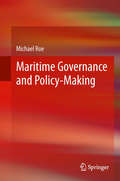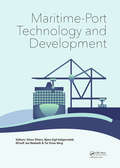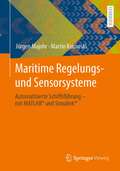- Table View
- List View
Marine Renewable Energy Handbook
by Bernard MultonMarine renewable energy is a significant resource for generating electricity, and if some conversion technologies have already reached a certain level of maturity, others are emerging. The originality of this multidisciplinary book is to offer a broad spectrum of knowledge from academic and industry experts of various origins. It deals with general aspects such as the specificities and constraints of the marine environment, the concepts of hydrodynamics and ocean engineering, as well as the industrial and economic sides necessary for the assembly of projects. It also discusses conversion technologies such as offshore wind, tidal power plants, tidal stream turbines, wave energy converters and ocean thermal energy plants. Finally, two chapters are devoted to power electronic conversion and power transmission cables.
Marine Resource Conservation and Poverty Reduction Strategies in Tanzania (Hamburg Studies on Maritime Affairs #8)
by Jennifer K. SesaboThe Tanzanian coastal areas are socially, nutritionally, economically and environmentally important, yet they are vulnerable to both over-exploitation and degradation of their habitats. This book demonstrates the extent which various socio-economic dimensions of rural coastal households influence livelihood pathways, production efficiency and attitudes towards conservation initiatives.
Marine Resource Damage Assessment: Liability and Compensation for Environmental Damage
by F. MaesThe main focus of this important book is on civil liability regimes to compensate for ecological/environmental damage, the impact of EC decision-making on the international regime for oil pollution damage, the use of environmental funds in this respect, the economic valuation of damage to the environment from a theoretical perspective and the application of the Contingent Valuation Method in Belgium for ecological damage at sea.
Marine Robot Autonomy
by Mae L. SetoAutonomy for Marine Robots provides a timely and insightful overview of intelligent autonomy in marine robots. A brief history of this emerging field is provided, along with a discussion of the challenges unique to the underwater environment and their impact on the level of intelligent autonomy required. Topics covered at length examine advanced frameworks, path-planning, fault tolerance, machine learning, and cooperation as relevant to marine robots that need intelligent autonomy.
Marine Robotics and Applications (Ocean Engineering & Oceanography #10)
by Luc Jaulin Andrea Caiti Marc Carreras Vincent Creuze Frédéric Plumet Benoît Zerr Annick Billon-CoatThis book reports on findings at the intersection between two related fields, namely coastal hydrography and marine robotics. On one side, it shows how the exploration of the ocean can be performed by autonomous underwater vehicles; on the other side, it shows how some methods from hydrography can be implemented in the localization and navigation of such vehicles, e.g. for target identification or path finding. Partially based on contributions presented at the conference Quantitative Monitoring of Underwater Environment, MOQESM, held on October 11-12, 2016, Brest, France, this book includes carefully revised and extended chapters presented at the conference, together with original papers not related to the event. All in all, it provides readers with a snapshot of current methods for sonar track registration, multi-vehicles control, collective exploration of underwater environments, optimization of propulsion systems, among others. More than that, the book is aimed as source of inspiration and tool to promote further discussions and collaboration between hydrographers, robotic specialists and other related communities.
Marine Simulation and Ship Manoeuvrability: Proceedings of the international conference, MARSIM '96, Copenhagen, Denmark, 9-13 September 1996
by M. S. ChislettReal-time, interactive ship simulators limped onto the scene, in the wake of flight simulators, some years ago. The maritime industries have a long history of conservatism, but this is now changing rapidly. The information age has also swept over ships and shipping, and has been taken to heart to such an extent that, for example, flight simulators now cooperate with ship simulators and import useful new concepts and methodologies. The more than 50 papers contained in this book show what and why. Although traditionally conservative, the marine world is also traditionally international and this has not changed. The papers in the book are by leading authors from all over the world and provide a detailed snap-shot of the rapidly advancing state-of-the-art, together with pointers to the future. The overall theme of MARSIM '96 and therefore also of this book is: Vessel manouevrability and marine simulation research, training and assessment, and includes original papers on topics such as bridge resource management, distant learning and simulators coupled via The Internet, virtual reality, neural networks, rudder-propeller hydrodynamics, prime mover models, squat in shallow water, and many more.
Marine Simulation and Ship Manoeuvrability: Proceedings of the international conference, MARSIM '96, Copenhagen, Denmark, 9-13 September 1996
by M. S. ChislettReal-time, interactive ship simulators limped onto the scene, in the wake of flight simulators, some years ago. The maritime industries have a long history of conservatism, but this is now changing rapidly. The information age has also swept over ships and shipping, and has been taken to heart to such an extent that, for example, flight simulators now cooperate with ship simulators and import useful new concepts and methodologies. The more than 50 papers contained in this book show what and why. Although traditionally conservative, the marine world is also traditionally international and this has not changed. The papers in the book are by leading authors from all over the world and provide a detailed snap-shot of the rapidly advancing state-of-the-art, together with pointers to the future. The overall theme of MARSIM '96 and therefore also of this book is: Vessel manouevrability and marine simulation research, training and assessment, and includes original papers on topics such as bridge resource management, distant learning and simulators coupled via The Internet, virtual reality, neural networks, rudder-propeller hydrodynamics, prime mover models, squat in shallow water, and many more.
Marine Structures Engineering: Specialized applications
by Gregory TsinkerMarine Structures Engineering is designed to help engineers meet the growing worldwide demand for construction of new ports and the modernization of existing ports and terminals. It provides an authoritative guide to the design, construction, rehabilitation, repair, and maintenance of port and harbor structures. Each chapter is self-contained, allowing readers to access specific information. The Author draws on his extensive experience in offshore structure and port engineering to demonstrate evaluation, rehabilitation, repair, and maintenance of in-service marine structures. Also covered in detail are state-of-the-art approaches to: *marine structures in cold regions, with special attention to the role of ice loads, permafrost, and other ice effects *shiplifts, marine railways, shipways, and dry docks *offshore moorings *floating breakwaters *marinas *structures that protect bridge piers from ship impact. Offering practical information on all aspects of marine structures, this book serves as an indispensable resource to all engineers and professionals involved in design, construction, maintenance, and modernization of ports and harbors.
Marine Surface Films: Chemical Characteristics, Influence on Air-Sea Interactions and Remote Sensing
by Martin Gade Heinrich Hühnerfuss Gerald M. KorenowskiSince the late 1960s, various groups have investigated the influence of marine surface films on mechanisms dominating energy and mass transfer across the ocean/atmosphere interface. However, a compendium summarizing the state-of-the-art research in this field is still missing. The book fills this gap and transfers the accumulated knowledge to the scientific community. After a brief historical chapter basic chemical insights are presented, followed by theoretical and experimental approaches carried out in laboratory facilities. Air-sea interaction experiments are then described and finally, remote sensing applications with sea slicks and crude oil spills are presented.
Marine Toxins as Research Tools (Progress in Molecular and Subcellular Biology #46)
by Nobuhiro Fusetani William KemMarine organisms produce a wide array of toxins, many of which are not only structurally unusual, but also show potent and interesting modes of action. Since the discovery of tetrodotoxin, a pufferfish toxin, as a potent and selective blocker of Na+ channels in 1964, it has been widely used as a research tool in pharmacological and physiological research. This has led to the identification of a number of important biological functions for Na+ channels. In recent years, much biological research has been carried out at molecular and cellular levels, and therefore selective inhibitors of enzymes and selective antagonist/agonists of receptors and channels have become increasingly important research tools. Accordingly, interest in using such compounds as reagents has increased. Marine toxins are some of the most popular research tools and have already contributed much to our understanding of biological processes and disease mechanisms.
Marine, Waterborne, and Water-Resistant Polymers: Chemistry and Applications
by Johannes Karl FinkThis book focuses on the chemistry of marine polymers, waterborne polymers, and water-resistant polymers, as well as the special applications of these materials. After the chemistry of marine polymers and their types are discussed, the uses of these polymers are detailed, as well as various analytical and characterization testing methods. The book also emphasizes the polymers that are most environmentally-friendly along with their origin and industrial applications. The polymers from these 3 types serve a variety of industries including medical equipment and devices, outdoor coatings and corrosion protection, food packaging, saltwater and freshwater marine purposes, paper, and marine well application, to name just a few.
Marine, Waterborne, and Water-Resistant Polymers: Chemistry and Applications
by Johannes Karl FinkThis book focuses on the chemistry of marine polymers, waterborne polymers, and water-resistant polymers, as well as the special applications of these materials. After the chemistry of marine polymers and their types are discussed, the uses of these polymers are detailed, as well as various analytical and characterization testing methods. The book also emphasizes the polymers that are most environmentally-friendly along with their origin and industrial applications. The polymers from these 3 types serve a variety of industries including medical equipment and devices, outdoor coatings and corrosion protection, food packaging, saltwater and freshwater marine purposes, paper, and marine well application, to name just a few.
Maritime Accident and Incident Investigation
by Alexander Arnfinn OlsenMaritime Accident and Incident Investigation covers a wide range of topics relating to maritime-orientated organisational hazards and risks, as well as root cause analyses and techniques for analysing evidence. Its approach to maritime casualty and incident investigation caters to the unique needs of the maritime industry and covers the human element, machinery and engineering, and structural and security concerns. The book is divided into four parts, which respectively introduce the concepts and theories of organisational risks and hazards; provide a framework structure for planning, initiating, performing, and closing out maritime casualty and incident investigations; provide an overview of the main forms of analyses; and offer a toolkit of forms and documents for preparing and carrying out incident investigations. Features: Focuses on basic principles independent of particular software or protocols, allowing customisation to the reader’s own management system, Health, Safety and Environment (HSE) programmes, or related initiatives Supports the reader in applying class-related activities such as the provisions of the ISM Code and the International Ship and Port Facility Security (ISPS) Code The book is ideal for trainees, advanced students, and junior maritime professionals involved in the investigation of maritime accidents and incidents. Also available as online Support Material is a full MaRCIIF Toolkit, containing several resources, such as checklists, forms, and guidelines, useful in the execution of maritime incident investigations. Access the Support Material: www.routledge.com/9781032530239 Alexander Arnfinn Olsen is a Senior Consultant at RINA Consulting Defence UK. He is STCW II 1995 qualified and has also worked as a marine training designer, marine auditor, and fisheries observer. He is the author of Introduction to Ship Operations and Onboard Safety, Core Concepts of Maritime Navigation, Introduction to Ship Engine Room Systems, Maritime Cargo Operations, Merchant Ship Types, and Firefighting and Fire Safety Systems on Ships (with Routledge).
Maritime Accident and Incident Investigation
by Alexander Arnfinn OlsenMaritime Accident and Incident Investigation covers a wide range of topics relating to maritime-orientated organisational hazards and risks, as well as root cause analyses and techniques for analysing evidence. Its approach to maritime casualty and incident investigation caters to the unique needs of the maritime industry and covers the human element, machinery and engineering, and structural and security concerns. The book is divided into four parts, which respectively introduce the concepts and theories of organisational risks and hazards; provide a framework structure for planning, initiating, performing, and closing out maritime casualty and incident investigations; provide an overview of the main forms of analyses; and offer a toolkit of forms and documents for preparing and carrying out incident investigations. Features: Focuses on basic principles independent of particular software or protocols, allowing customisation to the reader’s own management system, Health, Safety and Environment (HSE) programmes, or related initiatives Supports the reader in applying class-related activities such as the provisions of the ISM Code and the International Ship and Port Facility Security (ISPS) Code The book is ideal for trainees, advanced students, and junior maritime professionals involved in the investigation of maritime accidents and incidents. Also available as online Support Material is a full MaRCIIF Toolkit, containing several resources, such as checklists, forms, and guidelines, useful in the execution of maritime incident investigations. Access the Support Material: www.routledge.com/9781032530239 Alexander Arnfinn Olsen is a Senior Consultant at RINA Consulting Defence UK. He is STCW II 1995 qualified and has also worked as a marine training designer, marine auditor, and fisheries observer. He is the author of Introduction to Ship Operations and Onboard Safety, Core Concepts of Maritime Navigation, Introduction to Ship Engine Room Systems, Maritime Cargo Operations, Merchant Ship Types, and Firefighting and Fire Safety Systems on Ships (with Routledge).
Maritime Accidents and Environmental Pollution - The X-Press Pearl Disaster: Causes, Consequences, and Lessons Learned (Emergent Environmental Pollution)
by Meththika Vithanage Priyal de Alwis, Ajith Botheju BothejuThis book discusses in detail the facts and findings related to the X-Press Pearl container vessel accident that occurred in May 2021 off the coast of Colombo, Sri Lanka. The ship was carrying a large consignment of chemicals and diverse hazardous materials that caused a disastrous and vast environmental and social catastrophe in the region. Through many case studies, accumulated knowledge, and experiences, the authors discuss the accident response, risk mitigation, investigation, and damage assessment activities from the very onset of the accident. It helps researchers and regulators understand the facts of this unique marine chemical accident and to formulate necessary future regulations as well as to develop robust safety and sustainability management systems and safety cultures. Features: Written by authorities who led the team involved in accident response and damage assessment Focuses on identifying plausible root causes, pitfalls in accident response, and weaknesses in current regulatory and management protocols Delivers in-depth understanding of a unique marine chemical accident to help formulate necessary future policies and regulations related to such disasters Includes many case studies related to the accident illustrated with photos and figures that are true evidence of the disaster, the response, and the mitigation Explains and discusses key research findings in a streamlined manner understandable for a wide audience A valuable resource for readers in environmental management and policy creation, as well as for researchers, professionals, academics, and students involved in environmental science, chemical engineering, technical safety and sustainability management, maritime, polymer, and ocean sciences. Countries where maritime disasters are a concern will also find this book is an important guide for taking a responsible approach when handling similar situations in the future; not least to avert such events from occurring.
Maritime Accidents and Environmental Pollution - The X-Press Pearl Disaster: Causes, Consequences, and Lessons Learned (Emergent Environmental Pollution)
This book discusses in detail the facts and findings related to the X-Press Pearl container vessel accident that occurred in May 2021 off the coast of Colombo, Sri Lanka. The ship was carrying a large consignment of chemicals and diverse hazardous materials that caused a disastrous and vast environmental and social catastrophe in the region. Through many case studies, accumulated knowledge, and experiences, the authors discuss the accident response, risk mitigation, investigation, and damage assessment activities from the very onset of the accident. It helps researchers and regulators understand the facts of this unique marine chemical accident and to formulate necessary future regulations as well as to develop robust safety and sustainability management systems and safety cultures. Features: Written by authorities who led the team involved in accident response and damage assessment Focuses on identifying plausible root causes, pitfalls in accident response, and weaknesses in current regulatory and management protocols Delivers in-depth understanding of a unique marine chemical accident to help formulate necessary future policies and regulations related to such disasters Includes many case studies related to the accident illustrated with photos and figures that are true evidence of the disaster, the response, and the mitigation Explains and discusses key research findings in a streamlined manner understandable for a wide audience A valuable resource for readers in environmental management and policy creation, as well as for researchers, professionals, academics, and students involved in environmental science, chemical engineering, technical safety and sustainability management, maritime, polymer, and ocean sciences. Countries where maritime disasters are a concern will also find this book is an important guide for taking a responsible approach when handling similar situations in the future; not least to avert such events from occurring.
Maritime Cargo Operations
by Alexander Arnfinn OlsenMaritime Cargo Operations presents the core concepts of cargo work for marine engineering students and cadets. It is built around the essential principles of the maritime profession and is a valuable guide to a broad range of key subject areas in the safe carriage, handling, stowage and securing of cargo, and cargo watches in port. It contributes to a sound understanding of cargo operations for a future career in the profession, as well as offering a general overview for deck officers. Gives an overview of the key areas in cargo operations work. Includes structured Learning Outcomes and self-test questions for each subject area to assist readers in evaluating their understanding. The book suits merchant navy cadets at Higher National Certificate (HNC), and Higher National Diploma (HND), and foundation degree level in both the deck and engineering branches, and also serves as a general reference for maritime professionals.
Maritime Cargo Operations
by Alexander Arnfinn OlsenMaritime Cargo Operations presents the core concepts of cargo work for marine engineering students and cadets. It is built around the essential principles of the maritime profession and is a valuable guide to a broad range of key subject areas in the safe carriage, handling, stowage and securing of cargo, and cargo watches in port. It contributes to a sound understanding of cargo operations for a future career in the profession, as well as offering a general overview for deck officers. Gives an overview of the key areas in cargo operations work. Includes structured Learning Outcomes and self-test questions for each subject area to assist readers in evaluating their understanding. The book suits merchant navy cadets at Higher National Certificate (HNC), and Higher National Diploma (HND), and foundation degree level in both the deck and engineering branches, and also serves as a general reference for maritime professionals.
Maritime Containerlogistik: Leistungsvergleich von Containerschiffen in intermodalen Transportketten (VDI-Buch)
by Axel SchönknechtGrößenrekorde bei Containerschiffen überschlagen sich und ziehen gewaltige Infrastrukturinvestitionen in Hafenregionen nach sich. Dennoch fehlt bislang eine kritische Auseinandersetzung mit der zukünftigen Gestaltung von Containerseeverkehren. Der Autor erläutert die Chancen, Risiken und Anforderungen, die sich aus dem Größenwachstum der Containerschiffe ergeben. Innovative Gestaltungsmöglichkeiten für die Bereiche Schiff, Hafen und Hinterland bilden dabei einen Schwerpunkt. Die vorgestellten Methoden sind auf andere Seetransportketten übertragbar.
The Maritime Dimension of Sustainable Energy Security (Lecture Notes in Energy #68)
by Kapil NarulaThe maritime domain and sustainable energy are two critical aspects of the twenty first century which will shape the future of humanity. Although the maritime domain is inextricably interlinked with Sustainable Energy Security (SES), many aspects are discussed in isolated silos. This book aims to fill in this gap by presenting a holistic view of the maritime dimension of SES. It includes various topics such as the global energy system, energy supply chains, energy trade, shipping of energy commodities, energy markets, protection of maritime energy supply lines and the role of military in providing maritime security. It also focuses on harnessing offshore energy resources, both hydrocarbons and marine renewable energy and discusses the developments in lowering emissions from the shipping sector. The book is written for the general reader as well as students who are undergoing a course in energy systems, maritime management, naval studies and energy sustainability. The content is tailored to meet the intellectual curiosity of the inquisitive reader and introduces various specialized topics which are dealt in a simple and concise manner. It is hoped that this book would bridge the gap in the understanding of the maritime dimension of SES.
Maritime Economics: A Macroeconomic Approach
by E. Karakitsos L. VarnavidesThis book analyses shipping markets and their interdependence. This ground-breaking text develops a new macroeconomic approach to maritime economics and provides the reader with a more comprehensive understanding of the way modern shipping markets function.
Maritime Governance: Speed, Flow, Form Process
by Michael RoeThis book provides an original analysis of the problems facing global governance and in particular that of one of the most globalised of all industries – shipping. Central to all global trade and its dramatic growth, shipping faces difficulties of governance stemming from its every globalised nature. The current characteristics of global governance – nation-state fixation, anachronistic institutions, inadequate stakeholder involvement and an over-domination of owner interests are dwarfed by the problems of stasis and fixation which means that policies to address problems of safety, the environment and security are inadequate. This book provides a full and wide ranging discussion of how governance can be animated in a global context so that the dynamism of the maritime industry and its problems can be prevented, regulated and understood. Its unique approach to governance makes it essential reading for all maritime policy-makers and those analysing maritime issues, alongside those with an interest in governance in its widest sense.
Maritime Governance and Policy-Making
by Michael RoeA close analysis of the framework of existing governance and the existing jurisdictional arrangements for shipping and ports reveals that while policy-making is characterized by national considerations through flags, institutional representation at all jurisdictions and the inviolability of the state, the commercial, financial, legal and operational environment of the sector is almost wholly global. This governance mismatch means that in practice the maritime industry can avoid policies which it dislikes by trading nations off against one another, while enjoying the freedoms and benefits of a globalized economy. A Post-modern interpretation of this globalized society prompts suggestions for change in maritime policy-making so that the governance of the sector better matches more closely the environment in which shipping and ports operate. Maritime Governance and Policy-Making is a controversial commentary on the record of policy-making in the maritime sector and assesses whether the reason for continued policy failure rests with the inadequate governance of the sector. Maritime Governance and Policy-Making addresses fundamental questions of governance, jurisdiction and policy and applies them to the maritime sector. This makes it of much more interest to a much wider audience – including students, researchers, government officials, and those with industrial and commercial interests in the shipping and ports areas - and also of more value as it places the specific maritime issues into their wider context.Maritime Governance and Policy-Making addresses fundamental questions of governance, jurisdiction and policy and applies them to the maritime sector. This makes it of much more interest to a much wider audience – including students, researchers, government officials, and those with industrial and commercial interests in the shipping and ports areas - and also of more value as it places the specific maritime issues into their wider context.
Maritime-Port Technology and Development
by Sören Ehlers Bjorn Egil Asbjornslett Ornulf Jan Rodseth Tor Einar BergMaritime-Port Technology and Development contains the latest research results and innovations as presented at the 2014 International Maritime and Port Technology and Development Conference (Trondheim, Norway, 27- 29 October 2014). The volume is divided into a wide range of topics: Efficient and environmentally friendly energy use in ships and port
Maritime Regelungs- und Sensorsysteme: Automatisierte Schiffsführung – mit MATLAB® und Simulink®
by Jürgen Majohr Martin KurowskiDas Buch beschreibt die erforderlichen Grundlagen für den Entwurf und die Anwendung maritimer Regelungssysteme. Unter Verwendung moderner Methoden der Modellbildung und der Regelungstheorie erfolgt die Behandlung von Navigationssystemen und Sensoren, Regelungsstrukturen und Assistenzsystemen bis hin zu einem neuentwickelten Manöverregelungssystem. Der methodisch dargestellte Stoff wird durch eine Vielzahl von mit MATLAB® und Simulink® erstellten Rechenbeispielen und Simulationen auf der Basis von Borddaten anschaulich interpretiert.
